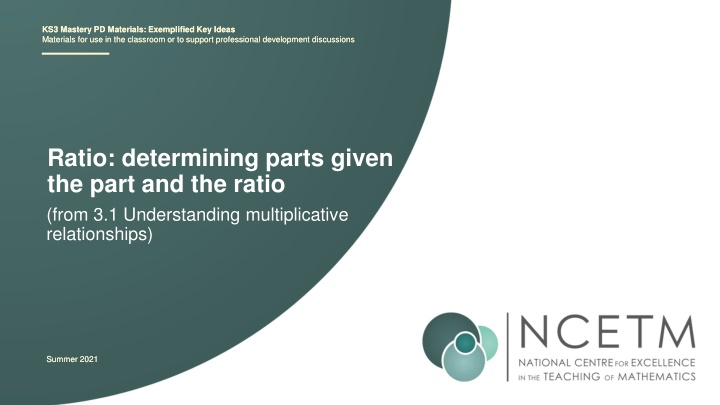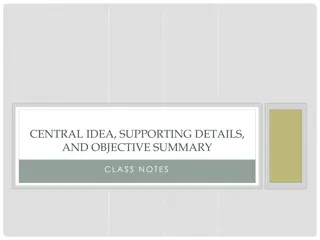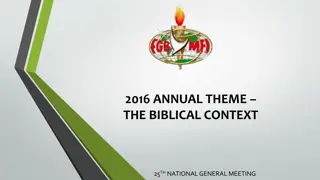
Multiplicative Relationships - Mastery Key Ideas for KS3
Explore exemplified key ideas on ratio determination in KS3 math education, featuring materials for classroom use or professional development discussions. Access slides designed to support teaching and learning, enhancing understanding of multiplicative relationships.
Download Presentation

Please find below an Image/Link to download the presentation.
The content on the website is provided AS IS for your information and personal use only. It may not be sold, licensed, or shared on other websites without obtaining consent from the author. If you encounter any issues during the download, it is possible that the publisher has removed the file from their server.
You are allowed to download the files provided on this website for personal or commercial use, subject to the condition that they are used lawfully. All files are the property of their respective owners.
The content on the website is provided AS IS for your information and personal use only. It may not be sold, licensed, or shared on other websites without obtaining consent from the author.
E N D
Presentation Transcript
KS3 Mastery PD Materials: Exemplified Key Ideas Materials for use in the classroom or to support professional development discussions Materials for use in the classroom or to support professional development discussions KS3 Mastery PD Materials: Exemplified Key Ideas Ratio: determining parts given the part and the ratio (from 3.1 Understanding multiplicative relationships) Summer 2021 Summer 2021
About this resource These slides are designed to complement the 3.1 Understanding Multiplicative Relationships Core Concept document and its associated Theme Overview document 3 Multiplicative Reasoning, both found in the Secondary Mastery Professional Development pages. These slides re-present the key examples from the Core Concept document so that the examples can be used either directly in the classroom or with a group of teachers. There are prompt questions alongside the examples, and further clarification in the notes. These slides do not fully replicate the Core Concept document, so should be used alongside it. Reference to specific page numbers, and to other useful NCETM resources, can be found in the notes for each slide. This slide deck is not designed to be a complete PD session, rather it is a selection of resources that you can adapt and use as needed when planning a session with a group of teachers.
About this resource The slides are structured as follows: The big picture: Where does this fit in? What do students need to understand? Why is this key idea important? Prior learning Misconceptions Exemplified key ideas Reflection questions Appendices: Key vocabulary Representations and structure Previous and Future learning Useful links The exemplified key idea slides have the following symbols to indicate how they have been designed to be used: Into the classroom The examples are presented on these slides so that they could be used in PD, but also directly in the classroom. The notes feature suggested questions and things teachers might consider when using with students. PDdiscussion prompts These slides look at the examples in more detail, with question prompts to promote discussion among maths teachers. The notes feature reference to further information and guidance within the Core Concepts document.
Where does this fit in? The NCETM has identified a set of six mathematical themes within Key Stage 3 mathematics that bring together a group of core concepts . The third of these themes is Multiplicative reasoning, which covers the following interconnected core concepts: 3.1 Understanding multiplicative relationships 3.2 Trigonometry
Where does this fit in? Within this core concept, 3.1 Understanding multiplicative relationships, there are six statements of knowledge, skills and understanding. These, in turn, are broken down into twenty three key ideas. The highlighted key idea is exemplified in this slide deck.
What do students need to understand? 3.1.4.3 Be able to determine one part, given the other part and the ratio What prior knowledge might your students already have? What language might they use to describe this key idea? What questions might you want to ask to assess their prior learning? Interpret mathematically a situation involving unequal sharing, using correct notation and relevant diagrams. Recognise the multiplicative relationship between a and b in the ratio a : b. Find missing parts when a quantity is divided into more than two unequal parts.
Why is this key idea important? Students may have previously met the idea of multiplication by thinking about equal groupings of objects and counting on in equal amounts from zero. As the numbers with which students work with extend beyond integers to include fractions and decimals, the scaling view of multiplication becomes increasingly important. Here, ratios are used to describe and explore multiplicative relationships. Students may still view some of these contexts additively, but it is vital that the multiplicative aspect is explored and emphasised. For example, in a question such as Some money is shared between Alan and Layla in the ratio 2 : 3. If Alan receives 10, how much does Layla receive? students may perceive an entirely additive structure: divide the whole into five parts, take two parts for Alan and three parts for Layla. However, students should also have the awareness that Alan and Layla s money is linked by multiplicative relationships: Layla has 3 Layla s share. Also, Alan has 2 The idea of a rate then becomes an integral part of this multiplicative relationship. The ratio 2 : 3 can be thought of as for every 2 Alan has, Layla has 3 or, by considering the multiplier, for every 1 Alan has, Layla has 1.50 . 2of Alan s share, and Alan has 2 5 of the total. 3 of 5 of the total and Layla has 3
Prior learning Upper Key Stage 2 Learning Outcome Multiply proper fractions and mixed numbers by whole numbers, supported by materials and diagrams Use all four operations to solve problems involving measure (for example, length, mass, volume, money) using decimal notation, including scaling Solve problems involving the relative sizes of two quantities where missing values can be found by using integer multiplication and division facts Solve problems involving the calculation of percentages (for example, of measures, and such as 15% of 360) and the use of percentages for comparison Solve problems involving similar shapes where the scale factor is known or can be found Solve problems involving unequal sharing and grouping, using knowledge of fractions and multiples What prior knowledge might your students already have? What language might they use to describe this key idea? What questions might you want to ask to assess their prior learning?
Checking prior learning a) Sam and Tom share 45 marbles in the ratio 2:3. How many more marbles does Tom have than Sam? b) Here are two similar right-angled triangles. Write the ratio of side a to side b. a : b = __ : __
Common difficulties and misconceptions What aspects of this key idea might pupils find challenging? What misconceptions might pupils have? When teaching this topic, you may find students encounter difficulties with 1) Recognising where relationships are multiplicative/additive in a problem 2) Assuming they need to know or find the total as a first step More information, and some suggestions for overcoming these challenges, can be found on the following slides.
Common difficulties and misconceptions (1) When solving problems involving unequal sharing, students may view a problem as a combination of multiplicative and additive processes. Consider the question Alice and Brenda share some money in the ratio 4 : 3. Alice has 20. How much does Brenda have? It is common for students to approach this problem by working multiplicatively: halve Alice s 20 to give 10, halve this again to give 5, and then additively combine these results to calculate that Brenda has 15. The use of a bar model representation in this situation can reinforce this combination of additive and multiplicative thinking:
Common difficulties and misconceptions (1 contd) However, the bar model, and other representations, can also be used to develop students awareness of the multiplicative structure that underpins this problem, illustrating that Brenda s share of the money is 3 in a way that is less apparent than when represented as the ratio 4 : 3. The multiplicative relationship becomes more important as students work with relationships involving less friendly numbers, where informal combinations of addition and multiplication can become unwieldy. 4of Alice s share
Common difficulties and misconceptions (2) Students may assume that it is necessary to know (or to calculate) the total quantity being shared as a first step, and so find problems difficult to access. The use of different representations to make the relationship between the ratio and the two shared parts can give students an opportunity to use more intuitive informal strategies.
Interpret mathematically a situation involving unequal sharing, using correct notation and relevant diagrams Example 1 Oscar and Pietro share some money in the ratio 2 : 3. Oscar s share is 9. Explain how each of these diagrams can help to calculate Pietro s share of the money. a) b) c) ncetm.org.uk
Interpret mathematically a situation involving unequal sharing, using correct notation and relevant diagrams Example 1 Reflect on the representations that you habitually use when teaching students how to find one part, given the other part and a ratio. Why do you use those representations? What are the benefits? What are the drawbacks? Reflect on the representations offered in Example 1. What are the benefits of each? What are the drawbacks of each? Oscar and Pietro share some money in the ratio 2 : 3. Oscar s share is 9. Explain how each of these diagrams can help to calculate Pietro s share of the money. a) c) b) ncetm.org.uk
Interpret mathematically a situation involving unequal sharing, using correct notation and relevant diagrams Example 2 Mark and Ahmed share some sweets in the ratio 1 :3. Ahmed has eight more sweets than Mark. How many does Mark have? ncetm.org.uk
Interpret mathematically a situation involving unequal sharing, using correct notation and relevant diagrams Example 2 Why might a bar model be a particularly useful representation of this problem? Mark and Ahmed share some sweets in the ratio 1:3. How many different questions can you pose using the number eight and the same ratio? How does the bar model differ for each? How can you support students to understand and represent the structures in each problem? Ahmed has eight more sweets than Mark. How many does Mark have? ncetm.org.uk
Recognise the multiplicative relationship between a and b in the ratio a : b Example 3 Richard and Sarah share some money in the ratio 2:5. For every two pounds that Richard has, Sarah has five pounds. Sarah always has two and a half times as much as Richard. Louis Matilda List some possible amounts that Richard and Sarah could have and explain how they show that both Louis and Matilda are correct. ncetm.org.uk
Recognise the multiplicative relationship between a and b in the ratio a : b Example 3 Richard and Sarah share some money in the ratio 2:5. Reflect on how you ve taught ratio in the past. Have you made explicit both the functional and the scalar relationship? For every two pounds that Richard has, Sarah has five pounds. Sarah always has two and a half times as much as Richard. How might having an understanding of both help students to understand the mathematical structure here? Louis Matilda List some possible amounts that Richard and Sarah could have and explain how they show that both Louis and Matilda are correct. ncetm.org.uk
Recognise the multiplicative relationship between a and b in the ratio a : b Example 3 (cont) Imagine a student says, If the ratio was 3 : 5, then the Sarah would have 3 and a half times as much as Richard. Richard and Sarah share some money in the ratio 2:5. For every two pounds that Richard has, Sarah has five pounds. Sarah always has two and a half times as much as Richard. How might this example have lead to this misunderstanding? How would you explain in? Louis Can you think of any other examples where number selection can lead to misconceptions? Matilda List some possible amounts that Richard and Sarah could have and explain how they show that both Louis and Matilda are correct. ncetm.org.uk
Recognise the multiplicative relationship between a and b in the ratio a : b Example 4 Erin and Laura share some money. Laura has 3 more than Erin. Erin and Laura have shared their money in the ratio 2 : 5. Emily Explain why Emily might think this and why she might not be right. ncetm.org.uk
Recognise the multiplicative relationship between a and b in the ratio a : b Example 4 Erin and Laura share some money. Laura has 3 more than Erin. Why might you want to use this non-example with your students? Erin and Laura have shared their money in the ratio 2 : 5. What other non-examples of ratio might you want to discuss with your students? Emily Explain why Emily might think this and why she might not be right. ncetm.org.uk
Recognise the multiplicative relationship between a and b in the ratio a : b Example 5 Sam and Cassidy share some money. James explains: Sam always has four times as much as Cassidy. In what ratio have Sam and Cassidy shared the money? Explain how you know. ncetm.org.uk
Recognise the multiplicative relationship between a and b in the ratio a : b Example 5 Sam and Cassidy share some money. What language would you want students to use when answering this question? James explains: Sam always has four times as much as Cassidy. What representations might you use to model this? In what ratio have Sam and Cassidy shared the money? Explain how you know. ncetm.org.uk
Recognise the multiplicative relationship between a and b in the ratio a : b Example 6 The ratio between the base length and the height of a rectangle is 3:1. a) Describe the rectangle is it short and fat or tall and thin? b) The ratio changes to 3:2 how has the shape of the rectangle changed? c) The ratio changes again to 3:3 how has the shape of the rectangle changed? d) What is the ratio when the height is double the length of the base? e) What is the ratio when the height is ten times the length of the base? f) What is the ratio when the height is two and a half times the length of the base? ncetm.org.uk
Recognise the multiplicative relationship between a and b in the ratio a : b Example 6 The ratio between the base length and the height of a rectangle is 3:1. a) Describe the rectangle is it short and fat or tall and thin? b) The ratio changes to 3:2 how has the shape of the rectangle changed? c) The ratio changes again to 3:3 how has the shape of the rectangle changed? d) What is the ratio when the height is double the length of the base? e) What is the ratio when the height is ten times the length of the base? f) What is the ratio when the height is two and a half times the length of the base? What might be the potential benefit of introducing a geometric context for ratio? How might you physically model this example in class? At what stage would you draw it? What other ratios might you model using this context? ncetm.org.uk
Find missing parts when a quantity is divided into more than two unequal parts Example 7a All of these rectangles are to be coloured yellow :red:blue in the ratio 1:2:3. Complete the shading on each rectangle. ncetm.org.uk
Find missing parts when a quantity is divided into more than two unequal parts Example 7a What different ways might your students approach this problem? What might that reveal about their understanding of the relationships here? All of these rectangles are to be coloured yellow:red:blue in the ratio 1:2:3. Complete the shading on each rectangle. Here are three potential answers for the rectangle with blue shaded. What differences in understanding might these suggest? ncetm.org.uk
Find missing parts when a quantity is divided into more than two unequal parts Example 7b All of these rectangles are to be coloured yellow :red:blue in the ratio 1:2:3. Draw the rest of each rectangle, then shade it in the same ratio as above. ncetm.org.uk
Find missing parts when a quantity is divided into more than two unequal parts Example 7b What different answers might your students give? What questions might you ask to explore these further? What is the effect of varying the colour but keeping the area coloured the same? How does this help expose the mathematical structure of this ratio? All of these rectangles are to be coloured yellow :red:blue in the ratio 1:2:3. Draw the rest of each rectangle, then shade it in the same ratio as above. ncetm.org.uk
Find missing parts when a quantity is divided into more than two unequal parts Example 8 Yasmine, Rachel and Brenda share some money in the ratio 1 :2:3. a) How much do Yasmine and Brenda each have if Rachel has 9? b) Brenda always has three times as much money as Yasmine. i. Write a sentence like this about the money that Rachel and Yasmine always have. ii. Write a sentence like this about the money that Rachel and Brenda always have. ncetm.org.uk
Find missing parts when a quantity is divided into more than two unequal parts Example 8 The images from example 7 have the same mathematical structure. How might you use these two examples in conjunction with each other? Yasmine, Rachel and Brenda share some money in the ratio 1:2:3. a) How much do Yasmine and Brenda each have if Rachel has 9? What might be the potential benefit of providing students with sentence structures to describe ratios? What other sentence structures might you use to explore this relationship? b) Brenda always has three times as much money as Yasmine. i. Write a sentence like this about the money that Rachel and Yasmine always have. ii. Write a sentence like this about the money that Rachel and Brenda always have. ncetm.org.uk
Reflection questions What other mathematical concepts will be supported by students stronger understanding of this key idea? What mathematical language will you continue to use to support pupils to make connections with other areas? Which representations might you continue to use to further develop students understanding?
Appendices You may choose to use the following slides when planning or delivering a PD session. They cover: Key vocabulary Representations and structure Previous learning Future learning Library of links
Key vocabulary Term proportion Definition 1. A part-to-whole comparison. Example: Where 20 is shared between two people in the ratio 3 :5, the first receives 7.50, which is 3 of the whole 20. This is the first person s proportion of the whole. 8 2. If two variables x and y are related by an equation of the form y = kx, then y is directly proportional to x; it may also be said that y varies directly as x. When y is plotted against x, this produces a straight line graph through the origin. ? ?, where k is 3. If two variables x and y are related by an equation of the form xy = k, or equivalently ? = a constant and x 0, y 0, they vary in inverse proportion to each other. A part-to-part comparison. The ratio of a to b is usually written a:b. ratio Example: In a recipe for pastry, fat and flour are mixed in the ratio 1 :2, which means that the fat used has half the mass of the flour. That is, fractional parts. ?????? ?? ??? ?????? ?? ?????=1 2 . Thus, ratios are equivalent to particular
Representations and structure There are a number of different representations that you may wish to use to support students understanding of this key idea. These might include: Bar models Bar models can be very useful to support students in representing (literally, re-presenting) problems in order to reveal multiplicative structures (as appropriate) and thus become aware of how to proceed to a solution. Ratio tables and double number lines (also known as stacked number lines ) The comparison of corresponding entries in two different sets of multiples, such as from a multiplication table, can be a useful context in which to explore multiplicative relationships.
Previous learning From Upper Key Stage 2, students will bring experience of: multiplying proper fractions and mixed numbers by whole numbers, supported by materials and diagrams recognising the per cent symbol (%) and understanding that per cent relates to number of parts per hundred , and writing percentages as a fraction with denominator 100, and as a decimal using all four operations to solve problems involving measure (for example, length, mass, volume, money) using decimal notation, including scaling solving problems involving the relative sizes of two quantities where missing values can be found by using integer multiplication and division facts solving problems involving the calculation of percentages (for example, of measures, and such as 15% of 360) and the use of percentages for comparison solving problems involving similar shapes where the scale factor is known or can be found solving problems involving unequal sharing and grouping, using knowledge of fractions and multiples.
Future learning In KS4, students will build on the core concepts in this mathematical theme to: compare lengths, areas and volumes using ratio notation and/or scale factors; make links to similarity (including trigonometric ratios) convert between related compound units (speed, rates of pay, prices, density, pressure) in numerical and algebraic contexts understand that ? is inversely proportional to ? is equivalent to ? is proportional to 1 ? {construct and} interpret equations that describe direct and inverse proportion interpret the gradient of a straight-line graph as a rate of change; recognise and interpret graphs that illustrate direct and inverse proportion {interpret the gradient at a point on a curve as the instantaneous rate of change; apply the concepts of instantaneous and average rate of change (gradients of tangents and chords) in numerical, algebraic and graphical contexts} set up, solve and interpret the answers in growth and decay problems, including compound interest {and work with general iterative processes}. Please note: Braces { } indicate additional mathematical content to be taught to more highly attaining students.
Library of links The following resources from the NCETM website have been referred to within this slide deck: NCETM Secondary Mastery Professional Development 3 Multiplicative Reasoning Theme Overview Document 3.1 Understanding Multiplicative Relationships Core Concept Document Using mathematical representations at KS3 | NCETM Insights from experienced teachers | NCETM NCETM primary mastery professional development materials NCETM primary assessment materials NCETM secondary assessment materials There are also references to: Standards & Testing Agency s past mathematics papers






















